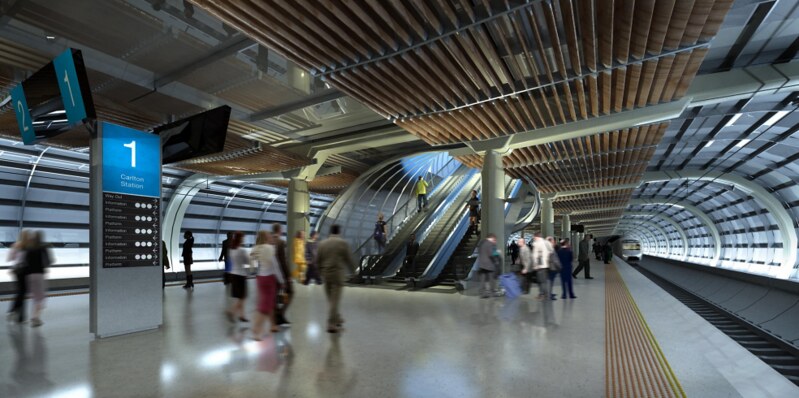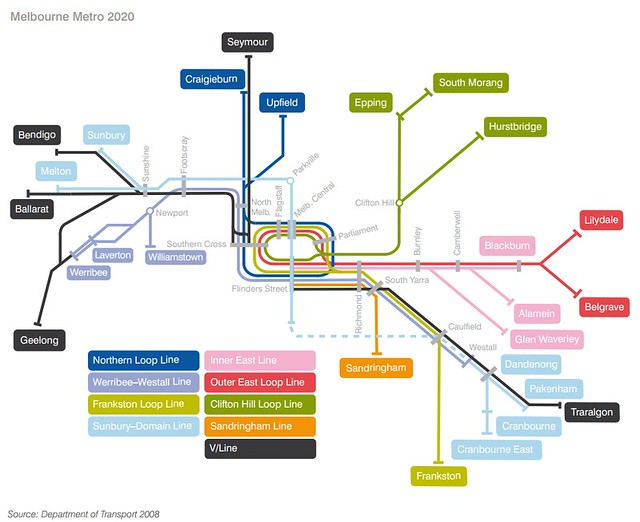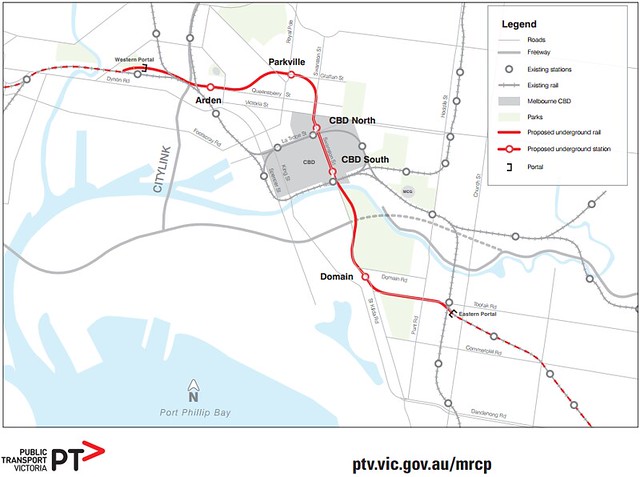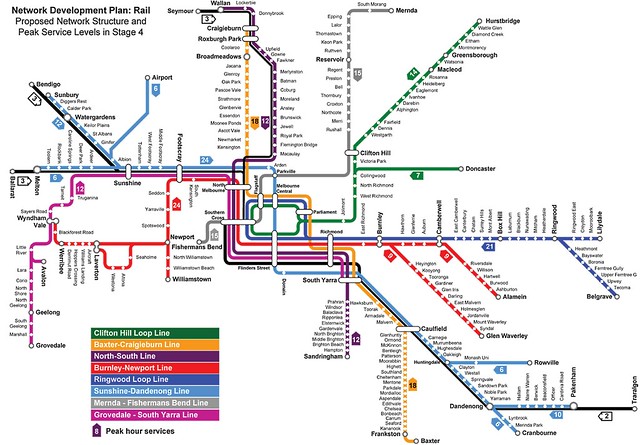There seems to be a little confusion over the various names of the Metro rail tunnel — for instance the name Metro One pops up regularly, especially out of the City Of Melbourne. The confusion is not surprising, as the name and design of the tunnel has changed a bit over the years.
Origins
The first glimpse of the idea came when Professor Graham Currie raised it back in 2005, I suspect helped along by ideas out the transport bureaucracy. Back then it didn’t have a name, but was compared in the media reports to the London Tube.
Professor Currie said the tunnel would link Melbourne University in the inner north to South Yarra station in the south, running for several kilometres under the central business district and St Kilda Road.
— The Age, Call for ‘tube’ line underneath Melbourne, 7/11/2005
Metro 1 and Metro 2
By the time of the Victorian Transport Plan in 2008, the tunnel was official government policy, an eventual 17km long tunnel linking Footscray with Caulfield, and to be built in two stages.
The Melbourne Metro – Rail Tunnel Stage 1 has an estimated cost of more than $4.5 billion. Stage 2 of the project will connect St Kilda Road (Domain) to Caulfield following the completion of Stage 1. Subject to Commonwealth support, development of Stage 1 is expected to start in 2012 and be completed by 2018.
–Victorian Transport Plan, 2008
Around that time they seemed to have a fascination with the word Metro, ensuring that it was also adopted as the name of the rail system itself when the new operator took over from Connex in 2009.
Metro rail systems are designed to run higher capacity trains from end to end of lines using dedicated tracks – the trains can run at higher frequency without interfering with other routes. The focus is on simple timetables, frequent services and consistent stopping patterns. Metro systems like those in London and New York have key interchange stations to allow people to change trains easily or switch to trams and buses to get to where they want to go.
–Victorian Transport Plan, 2008
This all makes sense, and it’s in that context that the rail tunnel has been emphasised — separating out rail lines and building extra CBD capacity to allow more lines to run independently.
So “Metro 1” was just the first stage, from Footscray to Domain, serving the Sunbury line. “Metro 2” was the remainder, to Caulfield, hooking up with the Dandenong line.
The big problem with building stage 1 and then waiting a while for stage 2 was that the capacity of the Sunbury line into Domain, and then having to reverse back out, 14 trains per hour, isn’t hugely greater than capacity of that line into the City Loop will be after Regional Rail Link is completed.
One tunnel to link them all
By 2012, the plan had been revised, with the tunnel shortened to run from Footscray to South Yarra, and to be built as a single project, and including a station to allow for urban renewal at Arden.
This submission builds on previous submissions to Infrastructure Australia – Melbourne Metro 1 (Ready to Proceed) and Melbourne Metro 2 (Real Potential). It is an interim step towards a submission defining a single project that will deliver the benefits of the two metro schemes. In doing so elements of the previous two submissions are combined and the project scope is being
refined in an effort to reduce costs.— Infrastructure Australia submission from the Victorian government, 2012
The Metro tunnel was worked into the (very interesting) PTV Network Development Plan for rail, released last year. It also included a second tunnel, eventually to divert the South Morang line via Parkville and Flagstaff, then to Southern Cross and out to Fishermens Bend.
The latest name: Metro Rail Capacity Project
A couple of months ago the project was officially renamed… which makes sense as the rail tunnel is just one component of a multi-faceted push to increase capacity across the rail network, including on lines that won’t get served by the rail tunnel(s).
Mind you, I can’t see this new name really catching on in popular usage because if the tunnel ever gets built, it’ll be the most expensive, most visible component.
In November 2013, the Melbourne Metro project was officially renamed as the Metro Rail Capacity Project. The new name better reflects the significant capacity benefits that the project will provide to the Sunbury, Upfield, Craigieburn, Pakenham, Cranbourne, Sandringham, Frankston, Werribee and Williamstown lines. On day one the project will enable an additional 20,000 passengers to travel on Melbourne’s rail network in the peak hour, as well as relieving congestion on St Kilda Road trams.
— PTV
And now?
Reports in the past week or two indicate the state government seems to be fumbling the project. The Premier has actively talked it down, suggesting it could result in Swanston Street being dug up for two years.
Various wild ideas have been thrown around, some trying to merge the original North-South Metro tunnel and the South Morang/Flagstaff/Fishermens Bend one:
- Footscray to Parkville (or possibly skipping that altogether), then via Flagstaff and Southern Cross to terminate at Fishermens Bend — thus missing the busiest part of the CBD — not much of a boost to capacity then is it, if it doesn’t go where the passengers want to get to
- Footscray to Southern Cross, then Fishermens Bend, Port Melbourne, Domain and South Yarra — successfully bypasses most of the CBD, yet likely to be just as expensive (possibly more so) than the original plan. This one has no specific status; it was floated by the anonymous SpringStSource
- Footscray, Parkville, then through the CBD under Russell Street, Domain and South Yarra — no doubt this would involve less surface disruption, as Russell Street isn’t as busy as Swanston street. But making people walk a full city block to interchange to trains and most trams would be far from ideal. This one was reported by The Age, but it’s unclear where it came from — it appears to be an idea from within PTV.
From what I can see, the 2012 plan is better than any of these, given it serves Parkville, Domain and busy Swanston Street — the only caveat being that it actually excludes an interchange at South Yarra, and is unclear about increased capacity from South Yarra to Caulfield. (Also to fully use the capacity, the Dandenong line needs to be sorted out, especially with regard to level crossing eliminations.)
Frankly I don’t trust reports that cut-and-cover has to be used all the way along Swanston Street, with two year long closures of the entire street, particularly as the tunnel has to be quite deep to get under the existing City Loop and Yarra River.
While they sort out when the tunnel will be built and where it should go (they’re a bit distracted by that other tunnel — the one nobody voted for), it’s once again worth mentioning that upgraded “moving block” signalling will provide a heap of extra train capacity — and there’s a heap that can be done to improve the tram corridor as well, with proper traffic light priority, especially along St Kilda Road. These upgrades can buy a few more years of capacity for a much smaller capital outlay.
And remember, “metro”-like frequent trains, every 10 minutes or better on all lines all day every day is largely possible right now, with existing infrastructure — and would be a huge boost to public transport network usability.
Inevitably though, the tunnel has to be built.
The CBD is growing, and getting busier, and suburban growth is concentrated on the Dandenong corridor and the western suburbs, which the tunnel will serve.
When it comes to public transport, those agglomeration benefits they talk about aren’t imaginary. Mass transit capacity is critical to continued accessibility and economic growth of central Melbourne, and thus the state.
- Further reading: Marcus Wong’s excellent blog post from 2012 on the history and proposed stations for the tunnel project
Update May 2014: the Coalition government has changed the tunnel route and given the project a new name: Melbourne Rail Link
Update January 2018: terminology has changed a little since this post was written.
Metro 1 is now commonly seen as referencing the first metro rail tunnel, currently under construction from South Kensington via Parkville, State Libary, Town Hall and ANZAC (Domain) to South Yarra.
Metro 2 is shorthand for the second proposed tunnel in the PTV Network Development Plan, from Clifton Hill via Flagstaff and Southern Cross to Fishermans Bend, with a possible extension under the Yarra River to Newport.




15 replies on “Metro 1/Metro 2/Metro Rail Capacity Project – The Metro rail tunnel’s many names”
Thanks for keeping us up to date. The title: Metro Rail Capacity Project doesn’t exactly roll off the tongue. I reckon it will be 10 years before we see the first sod turned for this project.
Vicroads has a survey open related to the removal of the murrumbeena road level crossing. So at least the crossing removal seems to be progressing.
The Age report said that the tunnel had been ruled out from going under the city loop because the depth of the stations would make emergency evacuations too difficult. And if it goes over the loop it’s too shallow for tunnelling, and so cut-and-cover was the only option.
“And remember, “metro”-like frequent trains, every 10 minutes or better on all lines all day every day is largely possible right now, with existing infrastructure — and would be a huge boost to public transport network usability.”
I’m interested to know how these frequencies on every line in Melbourne could be achieved with existing infrastructure (and by that, I mean: no changes to any of the existing rolling stock, signalling, tracks, level crossings, staffing levels, etc.) – of have I misunderstood what ‘existing infrastructure’ means? If I have, please could you explain which bits of the existing infrastructure would have to be changed (and how) to achieve these frequencies? Thanks!
@Keat, yeah the Springvale rail underpass is under construction; Murrumbeena should happen soon. But to unlock capacity (eg allow trains every 2-3 mins without the crossings being closed for all of peak hour), all the others in that area need to be done… and they’re mostly still unfunded… Grange Road, Koornang Road, Poath Road, Clayton Road, Centre Road. One would also hope they’re including provision for additional tracks.
@jon, the reasoning given doesn’t make sense in the context of other, deeper stations being built overseas (see Age letter on, I think, Saturday). Not to mention: how could they possibly do several years of detailed planning for the alignment before realising a simple fact like the depth required would mean it all had to be changed?
@ian, most of the network already runs more than 6 trains per hour in peak hour. There’s nothing in terms of track and fleet capacity stopping that happening all day – it’s a question of drivers, maintenance (including capacity to do that maintenance) and other running costs. The only parts of the network that can’t run every 10 minutes are predominantly to do with single-track sections. See http://www.ptua.org.au/2009/12/01/run-it-like-a-metro/
You should be able to reverse more than 14 trains per hour at a dead end – you just need to put some effort into designing the terminus. In the case of Hong Kong they run their 2 minute peak hour service into double track termini:
http://www.checkerboardhill.com/2011/05/terminating-trains-on-the-mtr/
You just need:
– ‘drop on’ drivers to take a train out as soon as it arrives, so you don’t wait for driver to walk down the train
– efficient signalling, so trains don’t occupy conflict points for longer than necessary
– modern train protection system and overrun tracks at the end of the platform, so trains can approach at higher speeds without the risk of hitting the end of the tunnel
Never mind overseas examples of stations 40m underground, our own Parliament Station is at 38m. Since trains don’t like grades, and Melbourne isn’t flat, some stations will be deep.
On the subject of getting the Domain–Parkville tunnel built, I agree Parkville is needed, but if the wrong tunnel route is chosen access from the south-east will be ruined for decades. Someone needs to sit down and think about overall aims for the system: capacity, express services for the long Dandenong and Frankston lines, and where the traffic is going. The Domain station appears to be poorly sited, marooned on a little island between the Shrine and Kingsway, chosen perhaps for interchange with the William St. tram. But that tram was itself a stopgap until Flagstaff was built – it’s a solved problem! Close it and a huge traffic snarl at Kingsway/Westgate goes away (this is largely traffic trying to avoid the city). Arden is a pointless frill when existing traffic generators such as St. Kilda Junction, Monash and the airport don’t have heavy rail.
I am very dubious about logic that runs “we don’t want to grade separate the Dandenong corridor, so we can’t run many trains, so they must be longer, so we need to build new stations”. In fact, grade separations and signalling make more sense.
Servicing the St. Kilda road commuters is a problem, but it might be cheaper to pay building owners to convert to residential than provide underground stations.
As for journey times, here’s a thought for the Frankston line: bored tunnel starting at Cheltenham, with interchanges at Gardenvale, St. Kilda Junction, Domain if you must, Parkville and one loop station. Then something similar for Dandenong with stations only at Monash and Chadstone. Hey presto, the Caulfield capacity and Monash problems solved. The thing is it’s the stations that are expensive, and starting and stopping the tunnelling machine rather than letting it run.
The capacity comparison for the Metro 1 terminating capacity is not the Northern Loop track it is either loop through-routing or Southern Cross platform 8 termination because they are the alternatives to that capacity.
Since tunnelling without stations is not comparatively expensive, I suggest starting the tunnel as Caulfield and running it along underneath the existing corridor to South Yarra and branching there.
P.S. The default language of comment on this blog has changed from English (Australia) to English (US). Please change it back.
There is a lot I do not like about this project.
#1, the whole idea is to reduce congestion on the existing railway corridors. As far as I can see it, there is no congestion between the city and Sunbury, thanks to the RRL. The other end is where congestion is more a problem, so why are we not starting from the Caulfield end?
#2, There are a number of more important projects of which we need. The Eddington-tunnel (I prefer that distinctive name over the too-generic name of Metro) roue is already well serviced with a number of tram routes. Higher capacity trams would be a far better option for this route.
#3, I value my direct access to Southern Cross station, without the need to change trains. I like to travel, and fear what the Eddinton-tunnel shall do to my travel plans.
Other more important projects would include the grade separation of the Dandenong line, as well as railways to Melbourne Airport alone is more important than the Eddinton-tunnel.
As for the claims that we need the Eddinton-tunnel to enable the Melbourne Airport, I say hell no. Melbourne Airport trains need only run express direct into Southern Cross. The existing RRL tracks should have more than enough capacity for those services. We need nothing more than a link from Airport west to Melbourne Airport, and a few trains, and we have an airport railway.
There are also a large quantity of little bits of works all over the system of which I feel are well overdue. Including the East Malvern interchange. Tram #3 and Alamein railway each extended by just a small amount to join up with the Glen Waverly line at East Malvern. That would result in a major enhancement for students attending the University at Caulfield, or punters attending Caulfield racecourse.
Would it be worth building an elevated railway over much of this section?
Doing that would save us a huge fortune. Should have plenty of change left over for other projects?
You could elevate it above Dandenong road from Malvern, then up St Kilda road.
Would there be an option to divert the line via Southern Cross, or perhaps do both?
Interestingly, I had a look at the Springvale Road project – and it’s not obvious that there’s scope for a third track through there.
In response to Tranzit Jim, the capacity issue is not strictly in the suburbs (though there are some issues out there).
The main capacity issue is the section in the city, ie: between Footscray and Richmond. This is where we need the capacity, and this is what the tunnel (with it’s 2 additional tracks) will deliver.
This rail tunnel shouldn’t be built at all, it detracts from the airport, Doncaster, Mernda and Roweville proposals. It is what I call an inititive sink and does not serve public transport but to delay the other proposals. In the end the tunnel proposal will be dropped and it will take years to ressurrect the other proposals.
This is why Napthine is fumbling and Abbott favours road funding, this tunnel proposal was never intended to be built but channel inititive to a dead end and delay the smaller proposals and favour road funding. The capacity argument is part of the process to gain universal support for a plan which is destinied to be dropped sometime about 2025.
I’d prefer the other proposals start now and the tunnel to link everything later but I’ll believe it when they dig the first sod.
Thanks for the summary.
It frustrates me to no end that the government can so easily ‘fumble’ what is a solid idea.
[…] Metro has been working on the Metro Rail Capacity Project since 2009 aiming to let an extra 35,000 commuters onto trains during peak hour and reducing congestion on St Kilda Road trams. […]